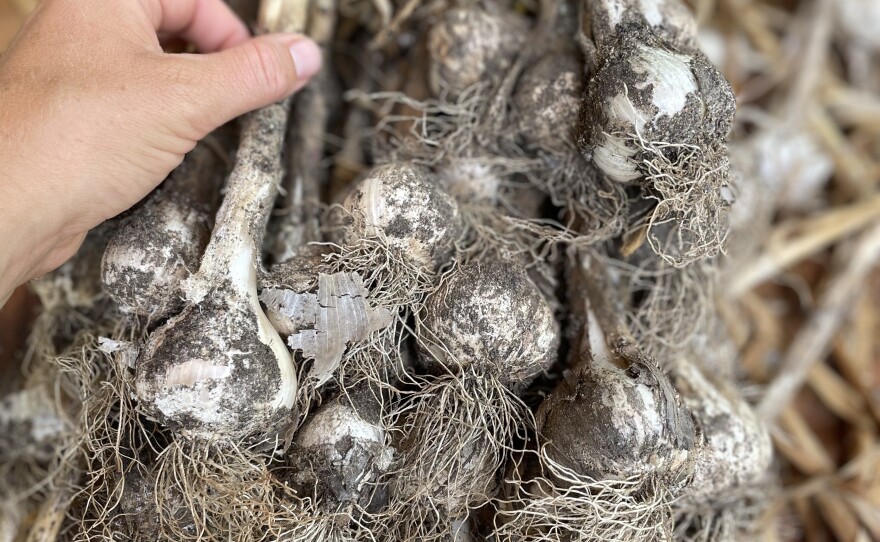Carrie Richter of Peach Tree Circle Farm in Falmouth is a self-proclaimed garlic fanatic.
"It makes every dish better. There's nothing about garlic that I don't like."
Take, for instance, the planting schedule:
"I love that you planted in the fall, which you're not harvesting anything at the time. There's not that many markets. You have plenty of time to do it. There's no rush," she said.
"You just have to do it before the, you know, the ground freezes, which generally around here is January. So I do it pretty late. I get it all in at my leisure. That's wonderful. It starts growing. You can then start selling it as green garlic, which is just it's like a scallion. You pull the whole plant and you chop it up like a scallion up into the leaves. Then you can sell the scapes."
The scapes are the twisty green stalks the plants send up to burst open into flower.
"And the scapes are delicious. Potatoes grilled. Pickled. There's a lot of things you can do with scapes. And then you pull the bulb."
It’s time for that when the leaves start to yellow and whither.
"And you can start selling it as fresh garlic. It's just full of moisture. It's creamy. It's delicious. But it is a little bit different than the garlic that you get at the store, because that stuff’s been cured, and fresh garlic hasn’t been cured yet."
Curing involves hanging just picked garlic bulbs with their stems still attached in a shady, well-ventilated spot — until the outer skins are dry and the center of the stems are hard. Then, it’s time to trim and clean them.
"The first thing we do when we clean it is just strip that outer layer right off and look how pristine and beautiful that is. The whole thing is just a painting, I mean, it's it's art. The garlic bulb is art," she explains.
"So you can grow it as that and then you, you don't. It's not like lettuce where you pick it, you wash it, you bring it. Nobody buys it. You compost it. This. The thing about garlic is you bring it back. It continues to cure. It doesn't matter. Sell it again next week."
It's a farmers’ dream. At one point, Carrie says, she was so in love with garlic that she was growing about 30 different types. But now, she’s pared down — to twenty.
"I’ve come to my senses over the years. I’m growing now my favorite ones. Most people when they grow garlic, they grow porcelains, which are the really big, beautiful white ones. Normally they have about 4 cloves per bulb and those cloves are enormous. I don’t grow those so much anymore, because I know everybody else has them. I’ll grow the smaller ones, the wilder ones, a lot of them are red, some of them unwrap themselves as you pick them, they just shift right out of their wrappers, so chefs love them for that reason."
That sounds like would definitely make the peeling process easier. Which is important — not only when you want to celebrate the harvest by putting fresh garlic on everything — but also, in Carrie’s kitchen, when it’s time to make something I’ve never heard of called garlic jelly:
"Which is SO good!—on cheese in particular, but cheeseburgers. It's garlic, it's vinegar, it's sugar. You don't necessarily think of that as being three things that you would put together, but yes, please do it. It's good. You want it on your cheese platter? My little sister bastes the outside of her pizza crust with it before she bakes it, and it just gets all caramelly and delicious. It is so good."
Garlic jelly! What a way to celebrate the harvest.
—
Here's a link to Carrie's website, where she has a whole page devoted wholly to garlic.










